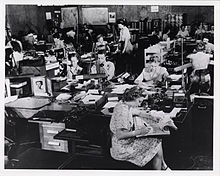Signal Security Agency
|
Signal Security Agency |
|
|---|---|
| State level | Federation |
| position | Signals intelligence |
| Headquarters | Arlington Hall Station, Virginia |
| Servants | approx. 10,000 (1945) |
| Web presence | - |

The signal Security Agency (SSA) ( German about "Nachrichtensicherheits- Agency " ) was the time of World War II, a secret service of the United States Army , that the Army of the United States of America . Their main task was the cryptanalysis , thus deciphering and clearing up the encrypted hostile message traffic .
history
First and foremost, the SSA dealt with the breach of encrypted radio messages of the main opponents of the war. These were the so-called " Axis Powers " at the time , ie the German Reich and its allies, the Kingdom of Italy and the Japanese Empire . They use very different manual and machine key procedures for their various military and diplomatic purposes, for example for military attachés . Prominent examples are the double box key and the one-time pad as well as encryption machines such as the Kryha , the Enigma , the " Purple ", the T52 "Secret Scribe" and the key addition SZ 42 .
Further targets of the SSA were the investigation of the communication of neutral states such as Switzerland . This in turn used a variant of the Enigma K with its own wiring of the rollers. Even French radio messages, such as encrypted using the B-211 of the Swedish inventor Boris Hagelin were intercepted and kryptanalysiert.
In addition to the areas of activity of so-called offensive cryptology described , defensive cryptology, i.e. checking and maintaining the stability of its own cryptographic procedures, was one of the tasks of the SSA.
The staffing of this remarkably successful agency grew from a few hundred military and civilian employees on the day of the Japanese attack on Pearl Harbor , December 7, 1941, to more than 10,000 employees on "VJ Day" , when it was on August 15, 1945 Surrender of Japan the Second World War ended. With the restructuring after the war, the SSA was initially part of the Army Security Agency (ASA) and is now part of the modern National Security Agency (NSA) .
literature
- David Kahn : The Codebreakers , MacMillan , New York , 1967, 1996, ISBN 0-684-83130-9 .
Web links
- History of the Signal Security Agency. Army Security Agency , Washington, DC , 1946 PDF; 255 MB (English), accessed January 4, 2019.
- The Achievements of the Signal Security Agency (SSA) in World War II. NSA , Fort Meade , 2010 PDF; 5.5 MB (English), accessed January 4, 2019.
- Official Publications of Signal Security Agency. Arlington Hall , 1945, PDF; 220 kB (English), accessed on January 4, 2019.
- Women's Army Corps of the Signal Security Agency , accessed January 4, 2019.

